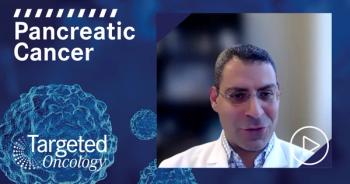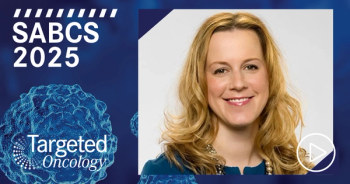
Highlighting Recent Changes and Recommendations for the Treatment of GIST
In an interview, Edwin Choy, MD, discussed the treatment landscape of GIST and recent changes to NCCN guidelines.
Over the past 20 years, the treatment landscape for patients with gastrointestinal stromal tumor (GIST) has evolved and now includes a few FDA-approved agents, like sunitinib (Sutent), regorafenib (Stivarga), ripretinib (Qinlock), and avapritinib (Ayvakit).
Imatinib (Gleevec), a targeted therapy drug, is often the first treatment used for patients with GIST. However, patients with advanced GIST or those unable to continue taking the drug, often due to adverse events, need different options.
In this case, the current second-line standard of care treatment for this patient population is sunitinib. Sunitinib targets the KIT gene and stops blood vessel growth in tumors. Another option is regorafenib.
Other targeted therapies, including ripretinib, which has been added to the National Comprehensive Cancer Network (NCCN) Clinical Practice Guidelines in Oncology (NCCN Guidelines), may be used to treat patients with GIST when sunitinib no longer works.
For patients who do not respond to these therapies, there are other tyrosine kinase inhibitor options, including pazopanib (Votrient), nilotinib (Tasigna), and dasatinib (Sprycel).1
“The universe of GIST and the scientists that do research on GIST have to be applauded for creating 5 drugs that can be effective for this disease in the last 20 years. Now, I think the trials have to better understand how to use them and in what sequence,” stated Edwin Choy, MD, in an interview with Targeted OncologyTM.
In the interview, Choy, director of the Sarcoma Program at the Division of Hematology Oncology at Massachusetts General Hospital, a founding member of Mass General Brigham, associate professor of medicine at Harvard Medical School, discussed the treatment landscape of GIST and recent changes to NCCN guidelines.
Targeted Oncology: What changes to work up at the primary presentation of GIST have been made to the NCCN guidelines?
Choy: Workup is pretty standard. For very small GIST, they can generally be followed. For just larger than 2 centimeters, we recommend a resection. Then in terms of staging, we recommend an abdominal pelvic CT scan to look for any early metastasis and other liver or abdominal lymph nodes. Once the tumor is resected, we would recommend the tumor be analyzed by experienced pathologists who have a lot of experience in diagnosing and creating GISTs. Those have been pretty standard recommendations for several years now.
What led to these recommendations? Are there any clinical trials or work in development that you can highlight?
Twenty years ago, there was a drug called imatinib that became very effective for GIST. Before that, there were no real effective drugs to treat GIST, so GIST was largely a surgical disease. We have a long record of how patients did without imatinib. In the 1970s, 1980s, 1990s, patients would be diagnosed with GIST and largely, if they have metastatic disease, they will eventually die from their disease in short order. If they had localized disease, their tumor would be surgically managed.
Depending on the size, grade and location of the GIST, they would have different risk levels, and levels of risk to develop metastasis. Once we developed imatinib as a treatment for metastatic disease, that changed the landscape of how we considered GIST. Where the disease had maybe a 6–12-month prognosis, using imatinib prolonged survival to 4-7 years. That changed how people did. In terms of how we want to initially manage GIST surgically, I don't think any of that has changed because as wonderful a drug as imatinib is, it doesn't change the sort of inherent risk of metastasis that a tumor would have when it's first diagnosed.
Can you discuss what the NCCN recommends in terms of neoadjuvant treatments for GIST?
In terms of neoadjuvant therapy, [recommendations are] broad, largely because we want to leave it up to the judgment of the clinicians. For example, if a GIST is located in the stomach close to the esophagus, sometimes in order to get a complete resection, we will have to perform a total gastrectomy. Patients who have had total gastrocnemius have a very awkward lifestyle in terms of how much they can eat, and what their life looks like without a stomach. To avoid a total gastrectomy, I would give neoadjuvant imatinib to shrink the tumor, downstage it, and make the resection more possible for a partial gastrectomy, which has a much better lifestyle than someone with a total gastrectomy.
The guidelines start by saying if GIST is resectable but has significant morbidity, such as a total gastrectomy, then they recommend mutation testing. The mutation testing would let us know how sensitive the tumor would be to one of our various drugs used to treat it. Depending on the mutation profile, if the mutation profile shows a tumor sensitive to imatinib, then it's reasonable to give maybe 6 months of preoperative imatinib therapy to downstage the tumor and make it more easily removable.
In the guideline, it also talks about how we can use different agents depending on what the tumor DNA sequencing results show. If the results show a mutation called D842V in PDGFRA, then those tumors would be uniquely sensitive to a drug called avapritinib [Ayvakit], which was designed with this mutation in mind. If the tumor had a mutation in NTRK, there are a number of commercially available NTRK inhibitors that have a good chance of creating a response in a tumor.
For young patients, their GIST tends to be wild-type, meaning they don't have an obvious mutation in either KIT or PDGFR, and in those patients, they usually have a deletion and SDH, so we call them SDH deficient GIST. For those patients, there aren't many great treatments for them. Of the available GIST drugs, we think that sunitinib may work better on these tumors than the other tyrosine kinase inhibitors. The NCCN recommends either using sunitinib or a clinical trial, or to try to get them to surgery. The NCCN recommends different agents depending on the molecule profile. In terms of clinical management, there's only a role for neoadjuvant therapy if it makes the surgery better.
What can you discuss about adjuvant treatments?
We have a lot of data on how patients do after their GIST is resected. We are able to understand that their risk of developing either a recurrence or metastasis is based on 3 factors based on tumor size. Larger than 5 centimeters is high-risk. Tumor grade, which is largely graded on mitosis, if you see more than 5 mitoses, then we will consider that high-grade. And then tumor location. The best risk for GIST is located in the stomach. But for GISTs that are located in the small bowel or rectum or elsewhere, they have a higher risk of developing metastasis and recurrence.
We combine those 3 characteristics to give an overall risk value for a patient. If we find that the risk of developing a recurrence or metastasis is high, given the tumor size, grade, and location, then there is data showing that we can improve overall survival by giving them adjuvant therapy for 3 years of imatinib. The other tyrosine kinase inhibitors typically used to treat GIST have not been as well studied as adjuvant therapy. However, if you do the mutation testing and you show that it does not have typical mutations that are sensitive to imatinib, then, there is less data for using imatinib in those situations.
What are the recommendations for the treatment of frontline GIST?
We want to sequence tumor DNA. When one say frontline, I think of metastatic disease, because if they don't have metastases, I'm only thinking of neoadjuvant or adjuvant. In metastatic disease, before I make a decision, I would make sure that everyone has their tumor DNA sequenced. If it shows an imatinib-sensitive mutation, then imatinib is my first choice for first-line therapy and I would treat that at 400 milligrams per day. I would continue to use imatinib while repeating scans and we read lengths to make sure that there's no recurrence. I would continue to use imatinib as long as the patient tolerates the drug and the scans do not show for the progression of disease.
If the patient does not have imatinib-sensitive mutations, with less data, I would use whatever drug that the tumor profile seems to indicate. Again, if you have the D842 mutation, I would use avapritinib. If you have the NTRK mutation, I would use one of the NTRK inhibitors, and if one has an SDH deletion, I would think about using sunitinib, but try to involve the patients in a clinical trial.
Are there any important changes to the recommendations for a second-line GIST?
In the second-line, we like to use sunitinib because that is what we have the most data for. There are clinical trials ongoing to see if 1 of the newer drugs like avapritinib or riptretinib can be superior to sunitinib prior to a second-line therapy. Those trials are still not mature in terms of their data. Unless the tumor mutation profile shows us to do something different, I think largely, sunitinib is our preferred second-line therapy.
What can you tell us about the INTRIGUE trial of ripretinib and sunitinib in patients with second-line GIST?
The data is still not mature. The trial had an intermediate analysis with a data cutoff in September 2021. They enrolled a total of 453 patients and 163 were randomized to ripretinib, 227 were randomized to sunitinib, the median age was 60 years old, and the progression-free survival difference between the 2 arms were not statistically different. In terms of overall response rates, they found a slightly higher overall response rate for ripretinib vs sunitinib. The P value for that analysis was .03. However, the median overall survival was not reached in either arm yet, so they're not able to comment on any differences in median overall survival.
Preliminarily, there is some data here showing that ripretinib may have a higher overall response rate than sunitinib. But in terms of how long it keeps the tumor to control, we call that PFS, that is pretty much similar in both arms. I think this is an ongoing trial, but I'm looking forward to their mature data, when they do reach median overall survival, to see which of the 2 arms would have longer overall survival. Ultimately that's what we are after when we're treating metastatic disease.
What is important for community oncologists treating patients with GIST to know?
The universe of GIST and the scientists that do research on GIST have to be applauded for creating 5 drugs that can be effective for this disease in the last 20 years. Now, I think the trials have to better understand how to use them and in what sequence. You will see more trials like this where we're trying to see which of the 5 drugs or which of the remaining 4 drugs are going to be most effective in the second-line setting and the third-line setting.
Then ultimately, we'll have patients who go through all 5 drugs and have nothing else that they can use. That is an area of unmet need for patients with metastasis GIST. There's some research that may be going back and recycling some of these old medicines that they used before to see if they can also be effective. But there are also other drugs that we know can work on GIST that are not FDA-approved. Perhaps some of those drugs will also be included in these future clinical trials.











































